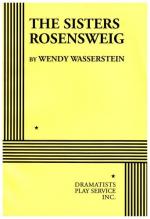|
This section contains 288 words (approx. 1 page at 400 words per page) |

|
The Sisters Rosensweig Summary & Study Guide Description
The Sisters Rosensweig Summary & Study Guide includes comprehensive information and analysis to help you understand the book. This study guide contains the following sections:
This detailed literature summary also contains Bibliography and a Free Quiz on The Sisters Rosensweig by Wendy Wasserstein.
The Sisters Rosensweig, Wendy Wasserstein's play about the transformative power of love, of sisterhood, and of life, was directed by Daniel Sullivan at Mitzi E. Newhouse Theater in New York City, opening in October 1992. Currently available in print, it was published in 1992 by the Dramatists Play Service in New York. The play is held together by the richly woven dialogue of three Jewish-American sisters pushing against the boundaries of their own lives in order to define themselves. Consequently, they do come to a point of resolution in their struggles, sometimes raising their voices in protest to be heard, at other times speaking softly in an attempt to hear themselves. Despite the absence of any action, the sisters manage to transform both themselves and their lives in the course of one evening. Another significant feature of the work is its ability to capture and make real several social and political issues that gave shape to the late part of the 1980s—the fall of the Soviet Union, Reaganomics, and the plight of the homeless, to name a few. In fact, the events discussed in the work are merely a reflection of what Wasserstein experienced in her own travels, first in eastern Europe, before the fall of the Soviet Union, and in Poland, in a town where she could see no evidence of her Jewish ancestry. It was her goal not only to raise certain political and social questions but also to illuminate her Jewish heritage, using her work as her vehicle. The play was admired by critics for its humor and insight, and it managed to earn the playwright both an Outer Critics Circle Award and an Antoinette Perry (Tony) Award nomination for best play in 1993.
Read more from the Study Guide
|
This section contains 288 words (approx. 1 page at 400 words per page) |

|



